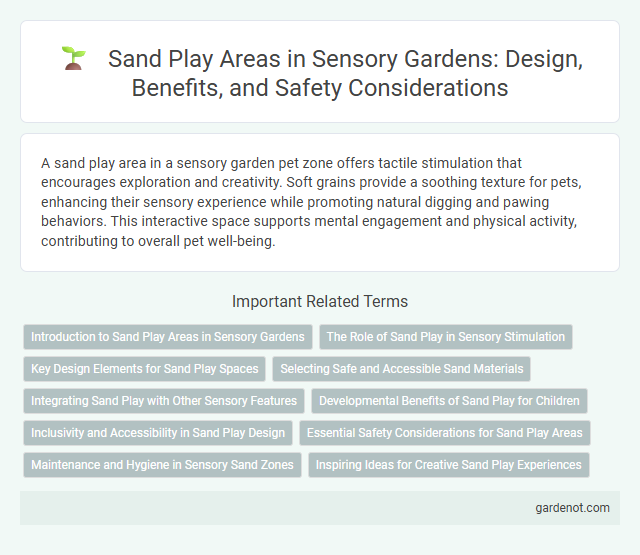A sand play area in a sensory garden pet zone offers tactile stimulation that encourages exploration and creativity. Soft grains provide a soothing texture for pets, enhancing their sensory experience while promoting natural digging and pawing behaviors. This interactive space supports mental engagement and physical activity, contributing to overall pet well-being.
Introduction to Sand Play Areas in Sensory Gardens
Sand play areas in sensory gardens provide tactile stimulation that enhances sensory development and creativity. These zones often feature varied textures, shapes, and tools designed to encourage exploration, fine motor skills, and imaginative play. Integrating sand play into sensory gardens supports cognitive growth and offers therapeutic benefits for individuals of all ages.
The Role of Sand Play in Sensory Stimulation
Sand play areas significantly enhance sensory stimulation by engaging multiple senses, including touch, sight, and sometimes even sound through the manipulation of sand textures and materials. The tactile experience in sand encourages fine motor skills development and cognitive growth as children explore different consistencies, temperatures, and forms. Incorporating natural elements like shells or small stones in the sand play area further enriches sensory input, providing a diverse and immersive environment essential for sensory integration therapy.
Key Design Elements for Sand Play Spaces
The sand play area incorporates natural materials such as fine-grain sand and wooden borders to create a safe, tactile environment that encourages sensory exploration. Key design elements include varied textures, built-in molds, and accessible play tools to stimulate creativity and fine motor skills. Strategic placement of shade structures and drainage systems enhances comfort and functionality, ensuring an inviting, sustainable sensory space.
Selecting Safe and Accessible Sand Materials
Selecting safe and accessible sand materials for a sensory garden sand play area requires choosing non-toxic, fine-grained sand free from harmful contaminants and allergens to ensure a healthy environment for all users. The sand should be soft enough to prevent injuries, easy to maintain, and suitable for children with sensory processing sensitivities, including those with mobility challenges. Incorporating sand blends with natural, hypoallergenic properties enhances tactile stimulation while promoting inclusivity and safety in the garden.
Integrating Sand Play with Other Sensory Features
Integrating sand play with other sensory features enhances the tactile, visual, and auditory experiences in a sensory garden, fostering multi-sensory engagement. Combining sand with water elements, textured stones, and aromatic plants creates an immersive environment that stimulates fine motor skills and encourages imaginative play. Incorporating diverse materials and sensory stimuli around the sand play area supports cognitive development and social interaction among users.
Developmental Benefits of Sand Play for Children
Sand play areas in sensory gardens enhance fine motor skills and hand-eye coordination by allowing children to manipulate textures and shapes. This tactile experience supports cognitive development by encouraging problem-solving, creativity, and spatial awareness. Engaging with sand also promotes social skills through cooperative play and communication among peers.
Inclusivity and Accessibility in Sand Play Design
Inclusive sand play areas prioritize accessible pathways, sensory-rich textures, and adaptable tools to accommodate children of all abilities. Incorporating raised sand tables and varied tactile elements enables wheelchair users and visually impaired children to engage fully and safely. Designing with universal access principles ensures that sand play fosters social interaction, creativity, and developmental benefits for every child.
Essential Safety Considerations for Sand Play Areas
Sand play areas in sensory gardens require non-toxic, fine-grain sand to prevent respiratory issues and skin irritation in children. Regular maintenance includes covering sand to protect against contamination from animals and debris, alongside routine cleaning and sand replacement every 6 to 12 months. Installing proper drainage systems prevents water accumulation, reducing the risk of mold and bacterial growth for a safe, hygienic play environment.
Maintenance and Hygiene in Sensory Sand Zones
Regular maintenance of sensory sand zones involves daily raking to prevent compaction and weekly removal of debris and foreign objects, ensuring a safe play environment. Hygiene protocols include periodic sand replacement every 6 to 12 months and the use of antimicrobial treatments to inhibit bacteria and mold growth. Adequate drainage systems and covered sandboxes reduce moisture accumulation, minimizing the risk of contamination and prolonging the sand's usability.
Inspiring Ideas for Creative Sand Play Experiences
A well-designed sand play area encourages imaginative exploration by incorporating diverse tools such as molds, scoops, and natural elements like shells and stones to enhance tactile stimulation. Introducing themed sand zones, like a construction site or a beach scenario, fosters narrative play and encourages collaborative creativity among children. Integrating sensory elements such as varying sand textures and hidden objects promotes fine motor skills development and sustained engagement.
Sand play area Infographic

 gardenot.com
gardenot.com